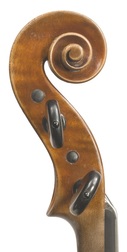
Giuseppe Ornati Milan, 1926
Giuseppe Ornati was was one of the most important Italian violin makers of his time. He began his career as a carpenter and began making instruments before he joined Leandro Bisiach's renowned workshop, where he became one of the shop's best pupils and craftsmen.
Ornati made instruments using his own model, but was clearly influenced by Stradivari patterns.
During WWI, Ornati worked as a woodworker at "Caproni," an airplane factory. In 1918, he returned to the Bisiach workshop and did repair work, although he had opened his own violin making workshop by then. Ornati competed in several violin making exhibitions, where he later participated as a judge. From 1961 to 1964, Ornati taught at the Cremona Violin Making School.
This violin is a stunning exmaple of Ornati's finest work and is in mint condition. He made the instrument for his daughter, with the phrase "Dono a mia figlia Carnelia" printed on the label. Photographs of this instrument are featured on page 206 in the first printing of Gualtiero Nicolini's book Liutai Italiani Di Ieri E Di Oggi.
Giuseppe Ornati was was one of the most important Italian violin makers of his time. He began his career as a carpenter and began making instruments before he joined Leandro Bisiach's renowned workshop, where he became one of the shop's best pupils and craftsmen.
Ornati made instruments using his own model, but was clearly influenced by Stradivari patterns.
During WWI, Ornati worked as a woodworker at "Caproni," an airplane factory. In 1918, he returned to the Bisiach workshop and did repair work, although he had opened his own violin making workshop by then. Ornati competed in several violin making exhibitions, where he later participated as a judge. From 1961 to 1964, Ornati taught at the Cremona Violin Making School.
This violin is a stunning exmaple of Ornati's finest work and is in mint condition. He made the instrument for his daughter, with the phrase "Dono a mia figlia Carnelia" printed on the label. Photographs of this instrument are featured on page 206 in the first printing of Gualtiero Nicolini's book Liutai Italiani Di Ieri E Di Oggi.
